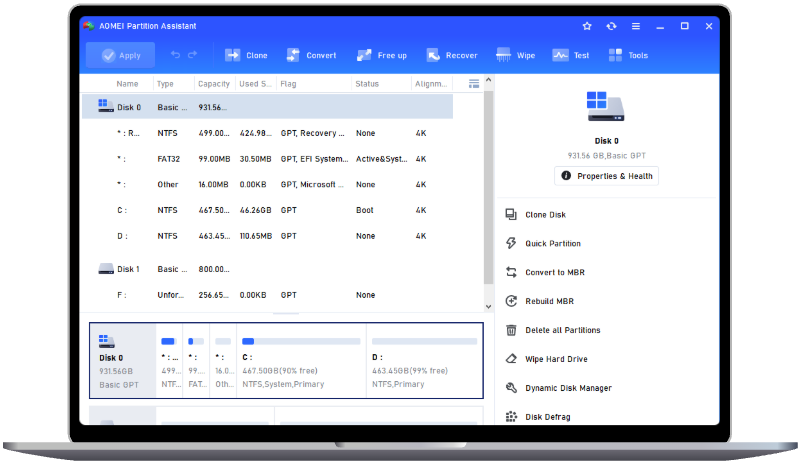[Fixed]: Does an Unallocated Partition Need to Be Formatted?
Does an unallocated partition need to be formatted? This post will explore why formatting is necessary for unallocated space and provide a step-by-step guide on how to format an unallocated partition effectively.
Does an unallocated partition need to be formatted?
An unallocated partition usually refers to disk space that has not been assigned to any partition. This space cannot be used for storing any data or programs, as the operating system does not recognize it.
Does an unallocated partition need to be formatted? Sure! To make full use of disk space, many users choose to format the unallocated partition. By doing so, you can create a file system on it, so that the operating system can store and retrieve data on that partition. It is a good option to optimize disk management and improve performance.
How to format an unallocated partition?
This section outlines three practical methods to format an unallocated partition. Before making any changes to your drive, please ensure you have backed up your data. Additionally, any programs running from the drive could interfere with the formatting process, so be sure to close them. Once you are prepared, follow the steps below to format your unallocated partition.
Solution 1. Format an Unallocated Partition Using Third-Party Software
When dealing with unallocated partitions on your hard drive, one of the most efficient ways to resolve the issue is by using third-party partition management tools. We highly recommend AOMEI Partition Assistant—a robust partition manager that is fully compatible with Windows 11, 10, 8/8.1, and 7. It supports a wide range of operations, including creating, cloning, resizing, and formatting partitions, among other common tasks. With just a few clicks, you can optimize your disk management.
To format an unallocated disk, you can create a partition on the unallocated space and choose the wanted file system format with AOMEI Partition Assistant. Here’s a step-by-step guide:
Step 1. Install and run AOMEI Partition Assistant. In the main interface, right-click the unallocated space on it and choose “Create Partition”.
Step 2. In the pop-up window, click "Advanced" to specify the information for the new partition, including partition size, partition label, drive letter, file system (we suggest NTFS), and partition type (logical or primary). You can also specify the size of the new partition by dragging both edges.
Step 3. You can preview the newly created partition in Pending Operations. Then, click “Apply” > “Proceed” to perform it.
Solution 2. Format an Unallocated Partition via Disk Management
Disk Management is a built-in tool in Windows that allows users to format drives or do other disk management operations. However, there are several limitations while using it. For example, you cannot format a partition over 32GB into FAT32 or execute the formatting operation when your hard drive becomes a RAW file system or write-protected.
Here’s how to format an unallocated partition with this tool:
Step 1. To open Disk Management, press Windows + R, type diskmgmt.msc, and press Enter.
Step 2. Right-click the unallocated space on the disk and select New Simple Volume.
Step 3. Follow the on-screen prompts to specify the volume’s size, drive letter, and format settings.
Step 4. Choose Format the Volume with the Following Settings and select your preferred file system format (e.g., NTFS).
Step 5. Click Next after choosing the correct parameters. Then complete the process by clicking Finish.
Solution 3. Format an Unallocated Partition via CMD
Diskpart is another good choice to format an unallocated partition if you are familiar with command lines. Follow these steps to format an unallocated partition using Command Prompt:
Step 1. To launch Diskpart, press Windows + R, type diskpart, and press Enter.
Step 2. Enter the following commands and press Enter after each one:
- list disk
- select disk X (replace X with the number of the unallocated partition you want to format)
- create partition primary size=[size] (specify the size of the partition as needed)
- format fs=fat32 (you can replace this command with format fs=ntfs or format fs=exfat based on your need)
- assign letter= f (assign a letter to the new partition)
Step 3. Once finished, type exit to close Diskpart.
Cannot format unallocated partition?
Formatting an unallocated space is not difficult but you may encounter the “cannot format unallocated partition?” error while processing. Here are several common causes:
➤ Hard Disk Type
You may fail to format the unallocated space by creating a partition on MBR. Because it only allows only 4 partitions or 3 primaries partitions plus 1 extended partition. If the number of partitions reaches the upper limit, consider converting one primary partition to logical one, and then you can create partitions on it.
➤ Peripheral Devices
Sometimes, Windows might mistake connected devices for primary drives, especially with MBR disks, preventing partition creation. It is advised to disconnect these devices and try again.
➤ Inactive Partitions
If the unallocated partition is inactive, the system won't recognize it. You have to activate it first before formatting.
Conclusion
This post addresses the issue, "Does an unallocated partition need to be formatted?" and provides a straightforward guide on how to format an unallocated partition. For an enhanced user experience, we highly recommend AOMEI Partition Assistant.
Apart from the functions mentioned above, this tool also enables partition resizing, moving, cloning, and other features, helping you streamline disk management while optimizing overall system performance.


